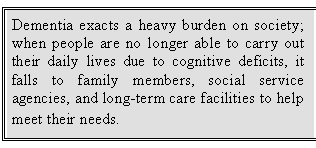AN OVERVIEW OF DEMENTIA
The adult brain weighs about three pounds, a scant 2% of the total weight of a 150-pound person. As insignificant as it is in size, this amazing organ allows us to carry out our everyday functions through the electrical and chemical processes that are constantly taking place among its 100 billion neurons, or nerve cells. These functions range from those that occur without our direction, such as breathing, heart rate, and digestion, to our sophisticated cognitive abilities, including thinking, learning, reasoning, remembering, making judgments, and speaking. Dementia results when the areas of the brain that are involved with cognitive functions are damaged, either through disease or trauma, to an extent that interferes with a person’s ability to perform day-to-day activities.
The brain is made up of three main structures: the cerebrum, the cerebellum, and the brainstem. The cerebrum, with its left and right hemispheres, accounts for 85% of the brain’s weight. Each of its two hemispheres consists of four lobes: frontal, parietal, occipital, and temporal. The hemispheres are connected by a thick bundle of nerves called the corpus callosum and are covered by the cerebral cortex, the outer layer comprising the “gray matter” of the brain. It is in the tightly packed neurons in the cerebral cortex that the regions of the brain involved in voluntary movement, sensory perceptions (e.g., seeing and hearing), memory, emotions, and speech reside. Conscious thought and mental activity are processed by the cortex.
Several essential parts of the brain lie deep within the cerebrum, in the “white matter” of the brain. These include the limbic system, which links the cerebral cortex to the brainstem. The limbic system includes the hippocampus (important for short-term memory), the amygdala (controls autonomic, emotional, and sexual behavior), the thalamus (relays sensory information), and the hypothalamus (monitors body temperature and food intake, among other activities).
The cerebellum, located at the base of the brain, accounts for slightly more than 10% of the brain. Responsible for balance and coordination, it receives information from the inner ear, eyes, and muscles to provide control over our movements. The brainstem is the smallest portion of the brain. It sits at the base of the brain, connecting the spinal cord to the rest of the brain. The brainstem controls our body’s automatic functions, such as heart rate, blood pressure, circulation, and breathing, as well as sleep and dreaming.
 The
brain has two principal kinds of cells, neurons and glia
cells. Our cognitive functions are made possible through the connections
that exist among the billions of neurons; glia cells, which outnumber neurons
by at least threefold, support and nourish neurons.
The
brain has two principal kinds of cells, neurons and glia
cells. Our cognitive functions are made possible through the connections
that exist among the billions of neurons; glia cells, which outnumber neurons
by at least threefold, support and nourish neurons.
Neurons are specialized cells that conduct and transmit electrical signals that, when assembled into circuits, pass sensory and motor signals to all areas of the body. Each neuron consists of many dendrites, short branches off the main body of the cell, and an axon, a long, thread-like extension of the cell that carries nerve impulses (electrical charges) to its end, where each electrical charge is transformed into a chemical messenger called a neurotransmitter. This messenger travels across a small gap, known as a synapse, to the receiving end of another cell’s dendrites. Once attached to the new cell, it is changed back into an electrical charge. Billions of these signals are constantly traveling the pathways of our brain, allowing us to receive and process information and send instructions to the various parts of our bodies.
Dementia occurs when there is disruption of the communication among neurons, through cell death or isolation. There are many different types of dementia; the causes of some types are known, while research is still trying to understand the processes that cause others. Some dementias are reversible or partially reversible through treatment, such as those caused by drug abuse, depression, or certain tumors; these, however, account for only about 20% of all dementia (1). The majority of dementias are irreversible.
Dementia exacts a heavy burden on society; when people are no longer able to carry out their daily lives due to cognitive deficits, it falls to family members, social service agencies, and long-term care facilities to help meet their needs. In the later stages of dementia, patients are totally dependent on others for their care. Life becomes a round-the-clock vigil for caregivers, many of whom are elderly and in poor health themselves. It is estimated that 50% of primary caregivers develop marked emotional distress (2). While many dementia patients live in long-term care (approximately one-half of nursing home residents suffer from dementia [3]), that represents just a small proportion of persons with dementia. From two-thirds to 95% (4) are cared for at home by families, until physical and emotional stress and financial hardship make home care too difficult.